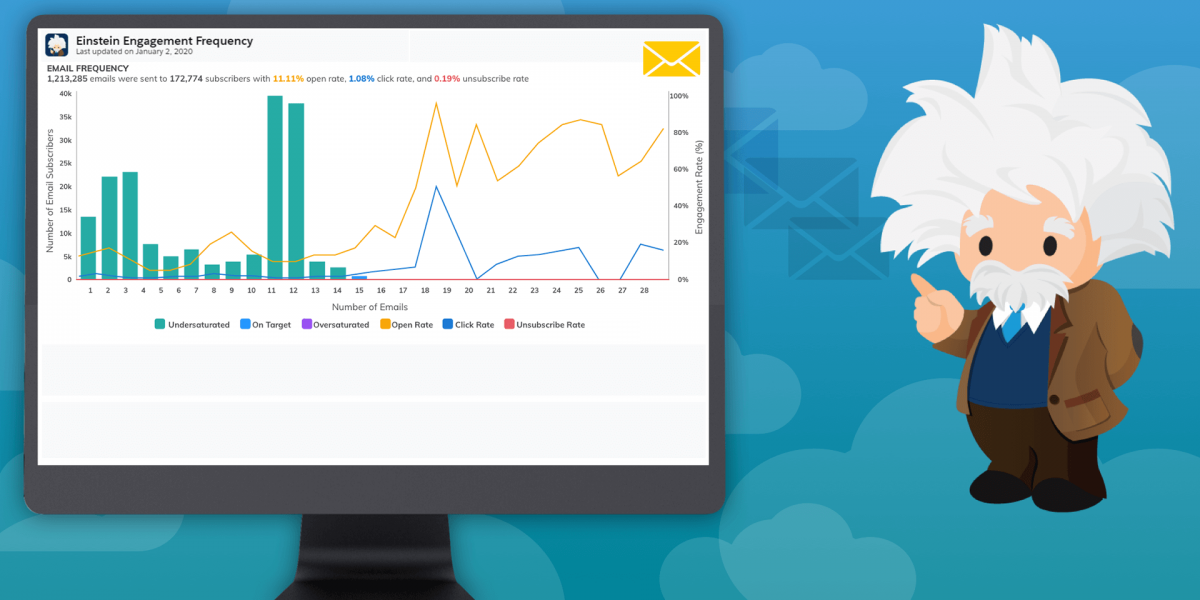This is part 2 of our Getting Started with Einstein for Marketing Cloud series. Visit KELL Labs to read the other blog posts in this series.
Do you send “too much” email? Or send too frequently? How much email is too much? I can’t tell you how many times I’ve been asked that question over the course of my 14 year career in digital marketing, but I can tell you very few people who have asked the question have ever gone through the effort to really know how much was “too much”….or too little. It’s simply a feeling usually based on a very little feedback. If you’ve determined you send too much email, the next and more difficult question is how much is the right amount?
Here’s the thing; if you’re sending relevant messages that people have opted in to receive then “too much” is a lot more than you think. If you’re buying lists, spamming people, sending irrelevant content or ignoring preference choices, then “too much” is barely any at all.
So how can we get some insight on this question without hours and hours of intense data analysis? The best place to start is Einstein Engagement Frequency, which is one of five new Einstein features added to Marketing Cloud in the second half of 2019. Let’s take a look at how to get started using this new Einstein analysis and at some of the key questions it can help us answer.
Setting Up Einstein Engagement Frequency
Einstein Engagement Frequency is easy to enable, and if you have the Corporate or Enterprise Edition it can be added and activated with no additional fee. If you don’t already see it under the Analytics Builder menu, then get in touch with Marketing Cloud Support or your Salesforce rep to get it enabled.
You’ll want at least 90 days worth of sending data, so if you’re brand new to Marketing Cloud you’ll need to wait a few months. If you have more than 90 days of data, there’s no reason to wait. Go ahead and activate it under the Analytics Builder menu. Once activated, it will take a few days to generate the initial frequency information.
What is the Right Frequency?
When you first go to Einstein Engagement Frequency, you’ll see a box like the one below. It tells you right off the bat what your optimal frequency should be based on actual history and optimization criteria that you can define. It also predicts what that optimal frequency will generate in terms of open rates or click rates. In this example, we chose open rates as our goal, but you can also select click-through rate or some weighted mix of opens, clicks and unsubscribes.
Are We Sending Too Much Email (YES!) or Too Little Email (ALSO YES!)
Gone are the days when everybody gets the same message at the same time. If you’re using Journey Builder, you’re probably sending different content to different segments. As a nonprofit, you might have one journey for recurring donors, one for volunteers and one for email subscribers. Even if you have a target frequency in mind, its very likely that some contacts are getting too much email and others are getting too little.
Einstein helps you figure out who is in which category. In the screenshot below, the red box outlines the summary of your oversaturated and undersaturated contacts. In this case, almost everyone is undersaturated.
The histogram also gives you insight into how the frequency affects your open rates and click rates. The bars show the segments of your contacts that are receiving too much, too little or just the right amount of email, each identified by different color bars. In the example above, almost everyone is undersaturated, so almost all of the bars are green.
You’ll also see yellow and blue lines representing how the open rate and click rate change based on frequency. Based on this data set, both of those numbers go up as the frequency increases.
Making the Data Actionable
The most powerful part of this Einstein feature is that it actually helps you put this information into action. For those contacts who get too much email, you’ll want to dial it back a little. For those who receive too little, you may want to bump up your frequency. Einstein Engagement Frequency empowers you to do exactly that.
In the screenshot above, note the link that says “Update Data Extensions” circled in red. (Note: The first time you do this, the link will say “Create” instead of “Update”.) Clicking this link will create/update two data extensions based on Einstein frequency suggestions. One will have contacts who have received too many emails and one will have contacts who have received too few emails based on the Einstein analysis.
These will land in your Data Extensions folder as sendable data extensions with the frequency data as additional fields. Since these are “standard” data extensions you can filter them as desired. You can send directly to them or you can use them as exclusions which would be the most logical use for the oversaturated group.
Tuning the Analysis Based on Your Goals
At the right of the screen, you’ll see a Data Filter box that lets you fine tune how Einstein performs the analysis. You can adjust things like:
- Which emails you “count” – commercial, transactional or both
- What to optimize – opens, clicks or a mix of open, clicks and unsubscribes
Note that you can change these configurations over time, so don’t worry if you’re not sure what the right settings should be the first time around.
This new Einstein feature is super powerful and I’m so excited to see how our clients will use it to make their communications more effective. If you’re interested in going farther and faster with Marketing Cloud and Einstein, contact KELL Partners. We have over a decade of Marketing Cloud experience and have been helping nonprofits and educational institutions with all things Salesforce since 2009. Contact us today!




